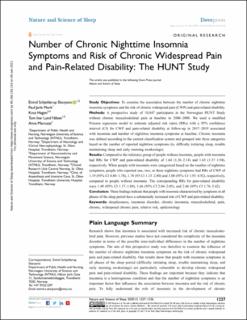| dc.contributor.author | Skarpsno, Eivind S. | |
| dc.contributor.author | Mork, Paul Jarle | |
| dc.contributor.author | Knut, Hagen | |
| dc.contributor.author | Nilsen, Tom Ivar Lund | |
| dc.contributor.author | Anna, Marcuzzi | |
| dc.date.accessioned | 2021-02-03T08:57:50Z | |
| dc.date.available | 2021-02-03T08:57:50Z | |
| dc.date.created | 2021-01-08T15:56:23Z | |
| dc.date.issued | 2019 | |
| dc.identifier.issn | 1179-1608 | |
| dc.identifier.uri | https://hdl.handle.net/11250/2725938 | |
| dc.description.abstract | Study Objectives: To examine the association between the number of chronic nighttime insomnia symptoms and the risk of chronic widespread pain (CWP) and pain-related disability.
Methods: A prospective study of 10,847 participants in the Norwegian HUNT Study without chronic musculoskeletal pain at baseline in 2006– 2008. We used a modified Poisson regression model to estimate adjusted risk ratios (RRs) with a 95% confidence interval (CI) for CWP and pain-related disability at follow-up in 2017– 2019 associated with insomnia and number of nighttime insomnia symptoms at baseline. Chronic insomnia was defined according to the current classification system and grouped into three categories based on the number of reported nighttime symptoms (ie, difficulty initiating sleep, trouble maintaining sleep and early morning awakenings).
Results: Compared to the reference group of people without insomnia, people with insomnia had RRs for CWP and pain-related disability of 1.64 (1.26– 2.14) and 1.63 (1.37– 1.94), respectively. When people with insomnia were categorized based on the number of nighttime symptoms, people who reported one, two, or three nighttime symptoms had RRs of CWP of 1.19 (95% CI 0.80– 1.78), 1.78 (95 CI 1.13– 2.80) and 3.08 (95% CI 1.93– 4.92), respectively, compared to people without insomnia. The corresponding RRs for pain-related disability were 1.49 (95% CI 1.17– 1.89), 1.46 (95% CI 2.04– 2.05), and 2.46 (95% CI 1.76– 3.42).
Conclusion: These findings indicate that people with insomnia characterized by symptoms in all phases of the sleep period have a substantially increased risk of CWP and pain-related disability. | en_US |
| dc.language.iso | eng | en_US |
| dc.publisher | Dove Medical Press | en_US |
| dc.rights | Navngivelse-Ikkekommersiell 4.0 Internasjonal | * |
| dc.rights.uri | http://creativecommons.org/licenses/by-nc/4.0/deed.no | * |
| dc.title | Number of Chronic Nighttime Insomnia Symptoms and Risk of Chronic Widespread Pain and Pain-Related Disability: The HUNT Study | en_US |
| dc.type | Peer reviewed | en_US |
| dc.type | Journal article | en_US |
| dc.description.version | publishedVersion | en_US |
| dc.source.journal | Nature and Science of Sleep | en_US |
| dc.identifier.doi | https://doi.org/10.2147/NSS.S284498 | |
| dc.identifier.cristin | 1867947 | |
| dc.description.localcode | This work is published and licensed by Dove Medical Press Limited. The full terms of this license are available at https://www.dovepress.com/terms.php and incorporate the Creative Commons Attribution - Non Commercial (unported, v3.0) License. By accessing the work you hereby accept the Terms. Non-commercial uses of the work are permitted without any further permission from Dove Medical Press Limited, provided the work is properly attributed. For permission for commercial use of this work, please see paragraphs 4.2 and 5 of our Terms. | en_US |
| cristin.ispublished | true | |
| cristin.fulltext | original | |
| cristin.qualitycode | 1 | |

